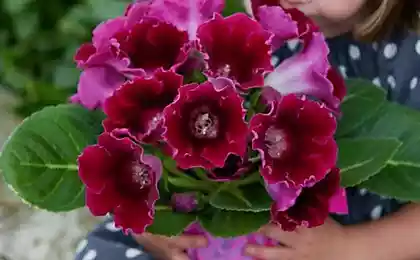514
How to know killed any plant or simply is in hibernation
Some people become less active in winter, and some plants is something like that. They hibernate when the temperature outside is very low temperature, and then come out of hibernation when conditions for growth become more favorable. During this slumber the leaves are falling, and it may seem that it died. But most likely it is not.
Fifty million five hundred eighty eight thousand nine hundred thirteen
It is obvious that garden plants undergo certain changes due to weather conditions, but plants are also exposed to them. Some plants are able to predict bad weather (usually it is connected with decrease or increase in temperature). Adverse weather conditions are the cause of hibernation, which flow into the plants. In fact, even many plants need this rest period to survive.
The types who just needed a rest, by no means to deprive him. If you try to create for their plants eternal summer, moving them into the house, such as the species as Japanese maple or maple genevey, not live in such conditions for more than two years. After the maximum period of continuous growth, a plant native to countries with a temperate climate, involuntarily go into a state of peace, regardless of the time of year or environmental conditions. Deciduous plants shed their leaves, evergreen does not give new sprouts.
As garden and house plants can hibernate after the received stress. For example, if a plant is not watered, it can relieve all the leaves and go to sleep to save the remaining moisture therein. It looks like it's dying, but actually a defense mechanism saves his life.
In order to check whether it died or just the plant is dormant, it is necessary to conduct an audit.
Cut off the tip of a twig the size of a pencil. Take the twig and sharply bend it back and forth a few times. Living twig will be easy to bend and will eventually split, exposing the wet wood inside. A dead twig will crack as soon as you bend it slightly and will be dry inside. You can also lightly scratched with a knife or fingernail the outer part of the branches.
If the plant alive under the bark it is green in color and slightly moist to the touch. A dead twig is brown, and you barely manage to scratch it.
In this case, you will need to continue to explore the stem and try to scratch the bottom a twig from the stem near the roots. The plant may show signs of life in these places. If this happens, you need to cut the dead stems almost to the root.
Despite the fact that it looks dead above the soil surface, from the sleeping plants living roots. If the test is a bending, or scratching twigs seem unconvincing, you can get a plant out of the pot and check to see if the roots look healthy and alive, or they are completely rotted or shrunk.
Rotten roots will produce odor, in this case this will mean that the plant died. If the roots will be flexible, it is opposite,will point to the fact that the plant just fell asleep.
It happens that some roots may be dead, others alive, including the root. Thus, to help the plant to optimize its resources and to revive with the onset of heat, you can trim the dead roots. Try not to touch the root and other healthy roots.
Ninety seven million two hundred forty eight thousand two hundred eleven
Your plant can fall asleep, but this does not mean that it is not in need of your care. He doesn't need light, but it stillit is necessary from time to time to pour once a month should be enough. Pretty easy maintenance, but in the cold period, many people water the plants as often as in summer, for example. This is detrimental to the plants from excessive watering they can die. In heated buildings the soil dries quickly, but only at the top, the deeper it can be humid.
To find out whether it is time to water your plant, dig the soil in the pot to the depth of 2-3 cm and touched the ground with his finger. If the ground is wet, the plant does not need watering.
How to use copper wire to get rid of Phytophthora on tomatoesHow to get a bumper crop of large, sweet beets
Rest is an integral part of the growth cycle of plants. In this case there's nothing you can do, except to wait for warmer days. Plants come out of hibernation as soon as the weather gets warmer and you notice new signs of life. And while you can trim the dead stems to make way for the new shoots.
As you can see, caring for the plants and not wanting to hurt them, you need to consider that they have periods of active growth and periods of dormancy.published
Source: mixstuff.ru/archives/123031
Fifty million five hundred eighty eight thousand nine hundred thirteen
It is obvious that garden plants undergo certain changes due to weather conditions, but plants are also exposed to them. Some plants are able to predict bad weather (usually it is connected with decrease or increase in temperature). Adverse weather conditions are the cause of hibernation, which flow into the plants. In fact, even many plants need this rest period to survive.
The types who just needed a rest, by no means to deprive him. If you try to create for their plants eternal summer, moving them into the house, such as the species as Japanese maple or maple genevey, not live in such conditions for more than two years. After the maximum period of continuous growth, a plant native to countries with a temperate climate, involuntarily go into a state of peace, regardless of the time of year or environmental conditions. Deciduous plants shed their leaves, evergreen does not give new sprouts.
As garden and house plants can hibernate after the received stress. For example, if a plant is not watered, it can relieve all the leaves and go to sleep to save the remaining moisture therein. It looks like it's dying, but actually a defense mechanism saves his life.
In order to check whether it died or just the plant is dormant, it is necessary to conduct an audit.
Cut off the tip of a twig the size of a pencil. Take the twig and sharply bend it back and forth a few times. Living twig will be easy to bend and will eventually split, exposing the wet wood inside. A dead twig will crack as soon as you bend it slightly and will be dry inside. You can also lightly scratched with a knife or fingernail the outer part of the branches.
If the plant alive under the bark it is green in color and slightly moist to the touch. A dead twig is brown, and you barely manage to scratch it.
In this case, you will need to continue to explore the stem and try to scratch the bottom a twig from the stem near the roots. The plant may show signs of life in these places. If this happens, you need to cut the dead stems almost to the root.
Despite the fact that it looks dead above the soil surface, from the sleeping plants living roots. If the test is a bending, or scratching twigs seem unconvincing, you can get a plant out of the pot and check to see if the roots look healthy and alive, or they are completely rotted or shrunk.
Rotten roots will produce odor, in this case this will mean that the plant died. If the roots will be flexible, it is opposite,will point to the fact that the plant just fell asleep.
It happens that some roots may be dead, others alive, including the root. Thus, to help the plant to optimize its resources and to revive with the onset of heat, you can trim the dead roots. Try not to touch the root and other healthy roots.
Ninety seven million two hundred forty eight thousand two hundred eleven
Your plant can fall asleep, but this does not mean that it is not in need of your care. He doesn't need light, but it stillit is necessary from time to time to pour once a month should be enough. Pretty easy maintenance, but in the cold period, many people water the plants as often as in summer, for example. This is detrimental to the plants from excessive watering they can die. In heated buildings the soil dries quickly, but only at the top, the deeper it can be humid.
To find out whether it is time to water your plant, dig the soil in the pot to the depth of 2-3 cm and touched the ground with his finger. If the ground is wet, the plant does not need watering.
How to use copper wire to get rid of Phytophthora on tomatoesHow to get a bumper crop of large, sweet beets
Rest is an integral part of the growth cycle of plants. In this case there's nothing you can do, except to wait for warmer days. Plants come out of hibernation as soon as the weather gets warmer and you notice new signs of life. And while you can trim the dead stems to make way for the new shoots.
As you can see, caring for the plants and not wanting to hurt them, you need to consider that they have periods of active growth and periods of dormancy.published
Source: mixstuff.ru/archives/123031






















